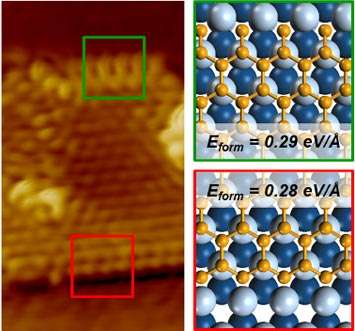Unraveling atomic-scale edge structure of nanoscale graphene islands

Through high resolution scanning tunneling microscopy measurements and first principles Density Functional Theory based calculations, a novel atomic scale edge structure was shown to be stable for graphene islands grown on cobalt surfaces. The low-coordinated carbon atom at the Klein edge structure is stabilized by interaction with the cobalt surface. This is the first demonstration, combining experiment and theory, that the interaction of the carbon atoms with a metal substrate stabilizes the low coordinated carbon edge atoms. In models for the growth of graphene on metal substrates, such low coordinated atoms at the growing edge play a special role. These results, which demonstrate such stability, will play a significant role in further development of these models and will help guide future strategies to grow graphene nanostructures with atomic scale control of edge structure.
A leading method to produce graphene nanostructures with potential for new electronic devices involves chemical reactions and growth of the one-atom thick graphene on metal surfaces. Low-coordinated carbon atoms at the growing edge play a key role in leading models for the growth mechanism. This work can lead to improved growth and the needed atomic-scale control of structure.
- CFN Capabilities: CFN Theory and Computation Facility: Prezzi from the Nanoscience Institute in Modena (Italy) and visitor to Columbia, in collaboration with Hybertsen from the CFN, performed quantum mechanical simulations of competing edge structures, showing that the zigzag and Klein structures with the final carbon atom over a hollow in the cobalt surface maximize interaction with the surface, stabilizing the low coordinated carbon atoms at the edges and explaining experimental observations.
- The Flynn, Nuckolls and Heinz groups at Columbia University grew graphene islands on the cobalt (0001) and measured the properties of these islands using scanning tunneling microscopy, demonstrating that the islands generally exhibited straight, well-oriented edges. High resolution images reveal the atomic scale differences between opposite edges.
More information: "Edge Structures for Nanoscale Graphene Islands on Co(0001) Surfaces." Deborah Prezzi, et al. ACS Nano 8 (6), 5765–5773, (2014)
Journal information: ACS Nano
Provided by Brookhaven National Laboratory




















